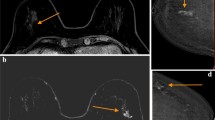Abstract
Background
In breast-conserving surgery (BCS), image-guided marking of the tumor border is important for preventing local recurrence and achieving a good cosmetic outcome. The purpose of this study was to evaluate the usefulness of multi-detector row computed tomography (MDCT)-guided marking technique before BCS in patients in whom ultrasound (US)-guided marking was not feasible.
Methods
Between 2004 and 2010, 94 lesions underwent contrast-enhanced MDCT-guided marking. Margin positivity and local control rates were compared with those of 149 lesions undergoing US-guided marking during the same period.
Results
In 21 lesions undergoing CT marking (22 %) and 20 lesions undergoing US marking (13 %), a negative resection margin could not be achieved, and hence the marking was judged as unsuccessful. Eighty-four lesions of the CT marking group and 119 of the US marking group received postoperative radiotherapy with 50 Gy in 25 fractions with or without an additional 10-Gy boost to the tumor bed. The remaining 10 and 30 patients, respectively, did not receive radiotherapy. The median follow-up period was 54 and 51 months for patients with CT marking and those with US marking, respectively. At 4 postoperative years, the local control rate was 96.5 % for patients with CT marking and 97.3 % for those with US marking (P = 0.89).
Conclusions
The MDCT marking technique appears to be a valuable tool for determining the surgical margin for BCS in patients in whom ultrasound marking cannot be performed. Combining this technique with appropriate postoperative radiation therapy is expected to yield reasonably high local control rates.





Similar content being viewed by others
References
Akashi-Tanaka S. Preoperative CT evaluation of intraductal spread of breast cancer and surgical treatment. Breast Cancer. 2011;20:21–5.
Köhler J, Krause B, Grunwald S, Thomas A, Köhler G, Schwesinger G, et al. Ultrasound and mammography guided wire marking of non-palpable breast lesions: analysis of 741 cases. Ultraschall Med. 2007;28:283–90.
Hayashi N, Tsunoda H, Abe E, Kikuchi M, Enokido K, Tsugawa K, et al. Ultrasonography- and/or mammography-guided breast conserving surgery for ductal carcinoma in situ of the breast: experience with 87 lesions. Breast Cancer. 2012;19:131–7.
Hata T, Takahashi H, Watanabe K, Takahashi M, Taguchi K, Itoh T, et al. Magnetic resonance imaging for preoperative evaluation of breast cancer: a comparative study with mammography and ultrasonography. J Am Coll Surg. 2004;198:190–7.
Inoue T, Tamaki Y, Hamada S, Yamamoto S, Sato Y, Tamura S, et al. Usefulness of three-dimensional multidetector-row CT images for preoperative evaluation of tumor extension in primary breast cancer patients. Breast Cancer Res Treat. 2005;89:119–25.
Akashi-Tanaka S, Fukutomi T, Miyakawa K, Uchiyama N, Tsuda H. Diagnostic value of contrast- enhanced computed tomography for diagnosing the intraductal component of breast cancer. Breast Cancer Res Treat. 1998;49:79–86.
Akashi-Tanaka S, Fukutomi T, Miyakawa K, Nanasawa T, Matsuo K, Hasegawa T, et al. Contrast-enhanced computed tomography for diagnosing the intraductal component and small invasive foci of breast cancer. Breast Cancer. 2001;8:10–5.
Uematsu T, Sano M, Homma K, Sato N. Value of three-dimensional helical CT image-guided planning for made-to-order lumpectomy in breast cancer patients. Breast J. 2004;10:33–7.
Uematsu T, Sano M, Homma K, Shiina M, Kobayashi S. Three- dimensional helical CT of the breast: accuracy for measuring extent of breast cancer candidates for breast-conserving surgery. Breast Cancer Res Treat. 2001;65:249–57.
Harada-Shoji N, Yamada T, Ishida T, Amari M, Suzuki A, Moriya T, et al. Usefulness of lesion image mapping with multidetector-row helical computed tomography using a dedicated skin marker in breast-conserving surgery. Eur Radiol. 2009;19:868–74.
Tamaki Y, Akashi-Tanaka S, Ishida T, Uematsu T, Sawai Y, Kusama M, et al. 3D imaging of intraductal spread of breast cancer and its clinical application for navigation surgery. Breast Cancer. 2002;9:289–95.
Akashi-Tanaka S, Sato N, Ohsumi S, Kimijima I, Inaji H, Teramoto S, et al. Evaluation of the usefulness of breast CT imaging in delineating tumor extent and guiding surgical management: a prospective multi-institutional study. Ann Surg. 2012;256:157–62.
Shibamoto Y, Naruse A, Fukuma H, Ayakawa S, Sugie C, Tomita N. Influence of contrast materials on dose calculation in radiotherapy planning using computed tomography for tumors at various anatomical regions: a prospective study. Radiother Oncol. 2007;84:52–5.
Kurtz JM, Jacquemier J, Amalric R, Brandone H, Ayme Y, Hans D, et al. Why are local recurrences after breast-conserving therapy more frequent in younger patients? J Clin Oncol. 1990;8:591–8.
Romestaing P, Lehingue Y, Carrie C, Coquard R, Montbarbon X, Ardiet JM, et al. Role of a 10-Gy boost in the conservative treatment of early breast cancer: results of a randomized clinical trial in Lyon, France. J Clin Oncol. 1997;15:963–8.
Fisher B, Anderson S, Bryant J, Margolese RG, Deutsch M, Fisher ER, et al. Twenty-year follow-up of a randomized trial comparing total mastectomy, lumpectomy, and lumpectomy plus irradiation for the treatment of invasive breast cancer. N Engl J Med. 2002;347:1233–41.
Anscher MS, Jones P, Prosnitz LR, Blackstock W, Hebert M, Reddick R, et al. Local failure and margin status in early-stage breast cancer treated with conservation surgery and radiation therapy. Ann Surg. 1993;218:22–8.
American College of Radiology. Breast imaging reporting data system (BI-RADS). 4th ed. Reston: American College of Radiology; 2003.
Tozaki M, Fukuda K. High-spatial-resolution MRI of non-masslike breast lesions: interpretation model based on BI-RADS MRI descriptors. Am J Roentgenol. 2006;187:330–7.
Ogawa T, Tozaki M, Yamashiro N, Kawano N, Suzuki T, Ozaki S, et al. New preoperative MRI marking technique for a patient with ductal carcinoma in situ. Breast Cancer. 2008;15:309–14.
Yamashiro N, Tozaki M, Ogawa T, Kawano N, Suzuki T, Ozaki S, et al. Preoperative MRI marking technique for the planning of breast-conserving surgery. Breast Cancer. 2009;16:223–8.
Conflict of interest
The authors declare that they have no conflict of interest.
Author information
Authors and Affiliations
Corresponding author
About this article
Cite this article
Urano, M., Shiraki, N., Hara, M. et al. Multi-detector row CT-guided marking technique for breast-conserving therapy of early breast cancer: margin positivity and local control rates. Breast Cancer 23, 252–260 (2016). https://doi.org/10.1007/s12282-014-0562-y
Received:
Accepted:
Published:
Issue Date:
DOI: https://doi.org/10.1007/s12282-014-0562-y




